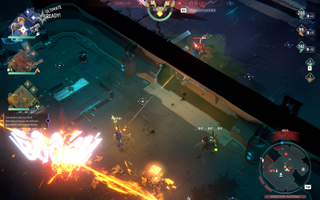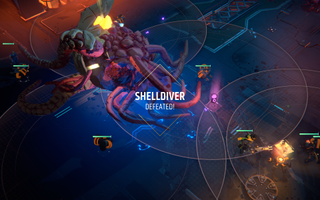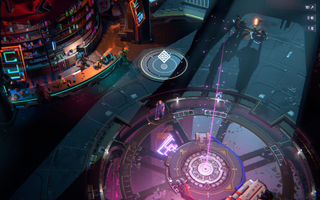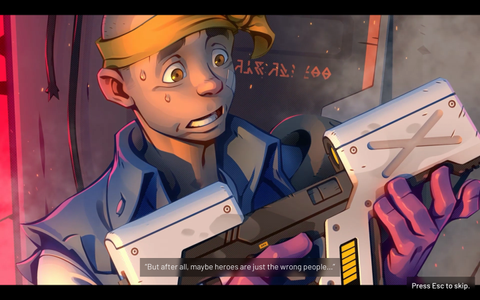Our Verdict
A touch too much repetition doesn't spoil this ambitious and elegant combo of run 'n' gun, tower defence, and roguelike.
PC Gamer's got your back
What is it? A unique combination of twin-stick shooting, roguelike dungeon crawling, and tower defence.
Release date October 19, 2023
Expect to pay £25 / $30
Developer Amplitude Studios
Publisher Sega
Reviewed on Intel Core i7-12700H, GeForce RTX 3060, GDDR6, 16GB RAM
Steam Deck Verified
Link Official site
There’s a lot going on in Endless Dungeon’s partially abandoned space terminal. Named ‘the Station’, it is the setting for a game that ambitiously blends elements from arcade-inspired run ‘n’ guns, strategic tower defence titles, and roguelite dungeon crawlers. That’s a lot to squeeze into a game in a cohesive and balanced way. And yet, for the most part, developer Amplitude has achieved it.
Endless Dungeon's narrative set-up is straightforward but effective: a band of outcasts have found themselves stranded on the Station, a hulking, multi-story mass of intertwined corridors and side rooms that once belonged to a mysterious group known as the Endless. Now the only other occupants are four tribes of monstrous creatures that maraud the Station’s tangle of decks.
Yours is the job of helping the squad of interstellar refugees escape their prison by pressing onwards through each floor, making their way down into the guts of the Station through multiple zones of generated dungeons. There’s a captivating core game loop to cycle through, but really this is a game about opening doors; a lot of doors. More on that in a moment.
Aesthetically and tonally, Endless Dungeons sits somewhere between cyberpunk convention and Hades’ handsome stylings. It's a delightfully pretty game, combining dramatically lit isometric interiors and cutscenes realised in sharp comic book form. The palette contrasts vibrant colour with shadowy gloom, and while it is unconcerned with realism, Amplitude’s creation bristles with detail, making the Station feel like a real and cohesive place. Fortunately, it is equally easy on the ear, with a rich soundscape and a score that capably brings tension and momentum.
But what about all those doors? Well, each playthrough starts in a singular room surrounded by exit points. Open up any of those bulkheads, and you’ll find yourself in another corridor or room, also resplendent with doors. There’s no obvious or linear route to the exit you ultimately seek, which will take you to the next stage—or down to the floor below. Equally, it’s typically next to impossible to know what exactly will be beyond any door you decide to burst through.

So it is that you pick your way through the Station's labyrinthine innards, unleashing a multidirectional spew of gaudy firepower whenever danger nears.
You might find an enemy spawn point, or a research console through which to upgrade your defensive technologies, or a gorgeous diorama scene scattered with collectibles. And so it is that you pick your way through the Station’s labyrinthine innards, unleashing a multidirectional spew of gaudy firepower whenever danger nears. You also have to guide a modestly-sized spider bot carrying a crystal that has the ability to open locked doors your squad alone can’t penetrate. The Crystal Bot will wait at certain points until you are ready to call it forth, and then expect you to usher it safely to its next destination.
Periodically, an enemy wave expands across all the rooms you have opened in a given zone, swarming the Crystal Bot and your squad of up to three combatants. If you’ve only revealed one or two spawn points, defence—hopping between squadmates as you please—isn’t much of an ask. But as you open more rooms and thus spawn points, quickly the waves become considerably testing. Fortunately, almost every open area is pocked marked with socket points on the floor, on each of which can be placed various turrets. And so it is that you open up an increasingly vast area, filling it with strategically placed turrets that might defend the waiting bot, or rain down hell on a spawn point while you explore far across the map.
Door to door

On passing through each door you are also granted pocket money amounts of three resources; Science, Industry, and Food. The first lets you use the Station’s scattered research consoles to develop new turret technology. Industry lets you place those precious turrets, as well as generators that up your reward for passing through each door. Food, meanwhile, grants your team health and performance upgrades. Turrets, equally, are essential in defending the generators you place.
Ultimately, then, when you’re not fending off a lengthy wave of monstrous hell, you explore, open up each procedurally generated stage, place your defences, and decide when to escort your bot accomplice to the next point where they are needed—which also immediately triggers a wave.
The ebb and flow between each state is deeply rewarding for the first few hours. The shooting action is tight and energetic, working particularly well with twin stick inputs via a pad. Different weapon pick-ups and mods, as well as newer turret types, can be used to exploit each monster type's weaknesses, but often skillful movement and carefully applied firepower is enough.

The design of the levels is particularly impressive—despite being procedurally generated, they almost always feel as if they must have been plotted by a human hand.
As each level blossoms to reveal ever more rooms and spawning points, so too the difficulty climbs, and the complexity of the challenge and strategic expectation broadens, and for a good while that’s powerfully captivating. However, while Endless Dungeon remains fun throughout, eventually repeatedly tumbling through that core loop does get a shade too familiar. The cast of players and weapons don’t bring quite enough variety, and more often than not finding a bottle neck through which to manage the waves of foes offers an increasingly repetitive solution.
That is to pick at a game that is, overall, impressive and engrossing. The design of the levels is particularly impressive—despite being procedurally generated, they almost always feel as if they must have been plotted by a human hand. Switch to online co-op multiplayer with friends or strangers, and Amplitude’s creation feels much less repetitive and considerably more dynamic. But perhaps it could have done with taking a little more from run ‘n’ guns’ arcade roots, employing shorter, punchier stages that steer the player clear from any sense of grind.
Ultimately, though, there are ample reasons to return over and over to Endless Dungeon’s quest to escape. And not just because it’s largely impossible to make your way through on the first few dozen attempts. Should your squad or the Crystal Bot perish, you are revived back at the top, in The Saloon, a charming bar area where you can spend additional in-game currencies upgrading weapons and more, all to increase your chances in the next run. You’ll also open alternative starting points that mean you don’t have to go back to the beginning each time.
And yet you might just want to, because with an embarrassment of riches when it comes to collectibles and upgrades, and a decent sized cast to spec out, there’s plenty of reasons to revisit Endless Dungeon over and over.
A touch too much repetition doesn't spoil this ambitious and elegant combo of run 'n' gun, tower defence, and roguelike.

